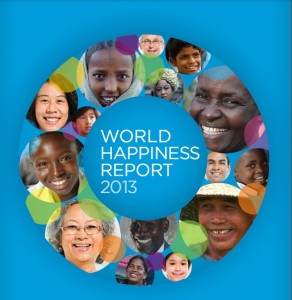
(Photo from UNSDSN)
Happiness seems a global obsession. Social media websites are filled with quotes trying to define the elusive ideal, with pages like “Happiness is” and “The Happy Page”. It is not a new concept. During the Victorian age, when morality reigned supreme, theorists like John Stuart Mill believed that the right action would lead to happiness and the wrong action to unhappiness. However, these days it seems a bit more complicated than that.
Nowadays, rich countries like Japan and Sweden record higher suicide rates than some countries in Africa. It is no longer about money or morality, but something beyond this. Happiness as a concept has become the eternal carrot, always coveted, never acquired.
Earlier this month, the United Nations published the 2013 World Happiness Report, where the level of happiness of countries were measured and listed.
According to the report, in July 2011, the General Assembly passed a resolution proposing that each country measures its own people’s happiness. The countries were given help guide by the United Nations explaining how this should be done. The first report was published in 2012 after the first “high-level meeting on happiness and well-being”. Shortly after, the Organisation for Economic Cooperation and Development (OECD) established an international standard for “the measurement of well-being”.
In the introduction, the report explains that it makes sure that respondents to the surveys understand the difference between happiness as an emotion and being happy with life as a whole. It also explains that confusion between the two aspects might lead to baffling results. “People living in extreme poverty do express low levels of happiness with life as a whole. Such answers should spur our societies to work harder to end extreme poverty.”
The surveys are divided into three sections: “measures of positive emotions (positive affect) including happiness; measures of negative emotions (negative affect); and evaluations of life as a whole.” Each section produces a report and these three reports are combined to form the final measure of happiness and well-being.
In addition to measuring happiness, the report also deals with causality, as in why the subjects have reported emotional happiness versus general happiness. Among their findings was the notion that “mental illness is the single most important cause of unhappiness, but is largely ignored by policy makers.” In addition, the report explains that even in developed countries, most people who are mentally ill do not seek treatment. Moreover, most mental illness medication and treatments are not covered in medical plans.
According to the report, there has been a general improvement from the 2007-2008 slump due to the recession. “The world has become a slightly happier and more generous place over the past five years.” The report attributes the improvement to “supports for better lives in Sub-Saharan Africa, continued convergence in the quality of the social fabric within greater Europe, and progress toward equality in the distribution of well-being among global regions.” This improvement was also recorded in Latin America, and it is despite the political and social crises in the Middle East.
The report also explains that it does not consider happiness as an “end” but rather a “mean” or a way of living. “It is important to emphasise that research does not prescribe extreme bliss but, rather, tentative evidence suggests that a moderate degree of happiness tends to be optimal for the effects surveyed.” The areas affected include: “(i) health & longevity; (ii) income, productivity, and organisational behaviour; and (iii) individual and social behaviour.”
An interesting aspect of the body of research surveyed for the report concluded that there is a direct correlation between happiness and risk-taking. “According to economic theory, happier individuals have more to lose from engaging in risky behaviour that may carry the risk of injury or death.” However, the research also concluded that a happier individual leads to a well-rounded human and citizen. “For example, they are less biased against other ethnic groups.”
Conversely, depression is one of the major factors behind disruptive or failed social behaviour. “Depression, which is characterised by low or absent positive feelings, creates problems in social relationships such as divorce, limited social support, and distancing from one’s neighbours.”
The report also discusses the evolution of happiness as a concept, which led to different schools of thought in the modern-day life. While economists believe that happiness can be acquired through high-income and consumption, psychologists believe that it is a combination of mental health and a positive state of mind.
The report also laments that modern-day theorists have moved away from the idea of virtue and ethics as sources of happiness. “The public is told, and generally believes, that the key to greater happiness is through more economic growth. This emphasis on economic growth as the principal path to happiness is relatively new, emerging gradually after 1700.” This led to the disappearance of the “good life” concept which was popular throughout history.
Finally, the report listed countries of the world starting with the happiest, taking in consideration factors such as GDP per capita, social support, life expectancy, generosity, corruption, positive and negative affects and freedom. Denmark was at the lead, followed by Norway and Switzerland. The least happy country was Togo coming at 156. Egypt was 16 countries earlier at 130, while the UAE was recorded at 14, Morocco at 99, Iraq at 105 and Tunisia at 104.
However, it is worth remembering that despite the saddening numbers and reality, happiness remains an achievable state of mind.




